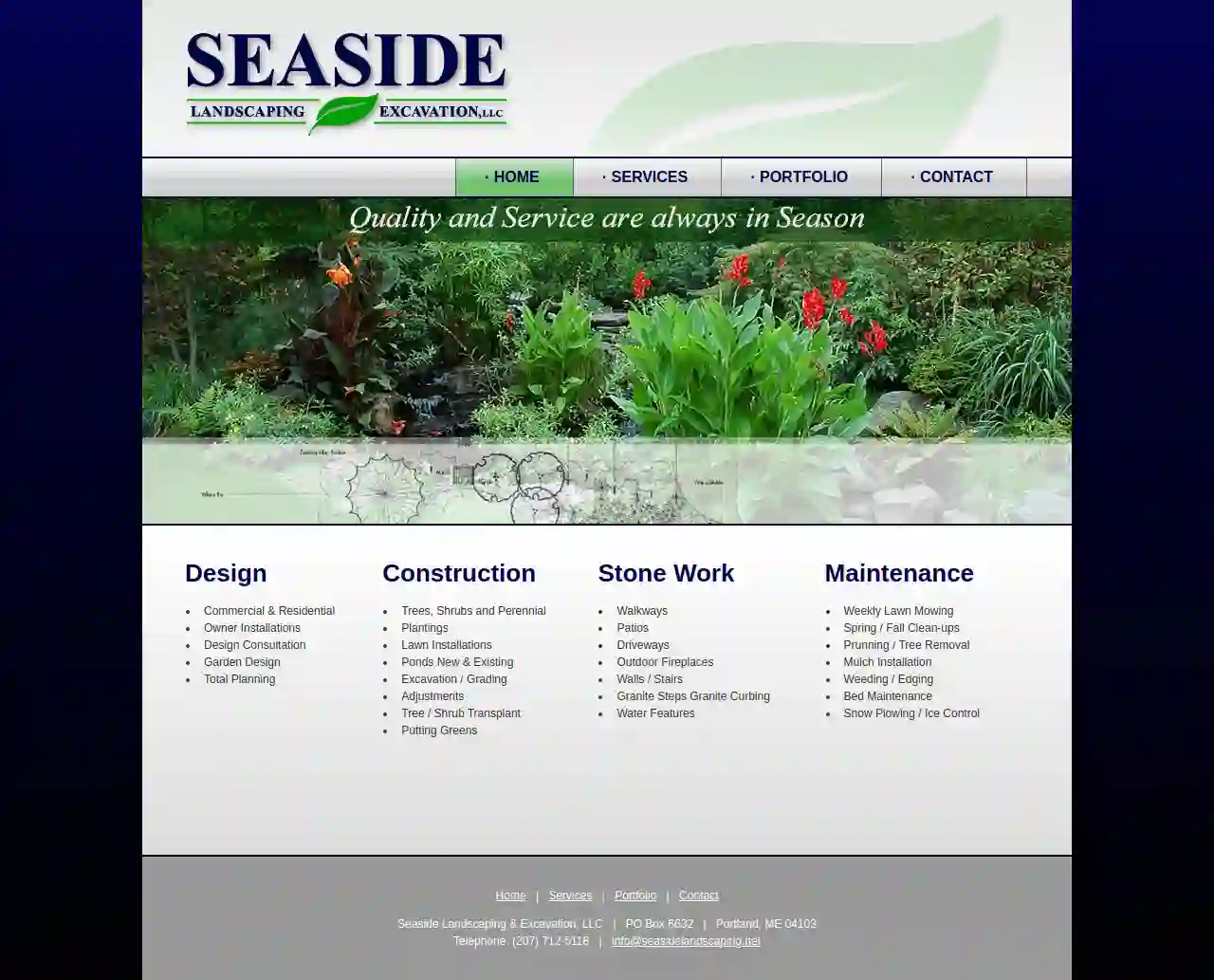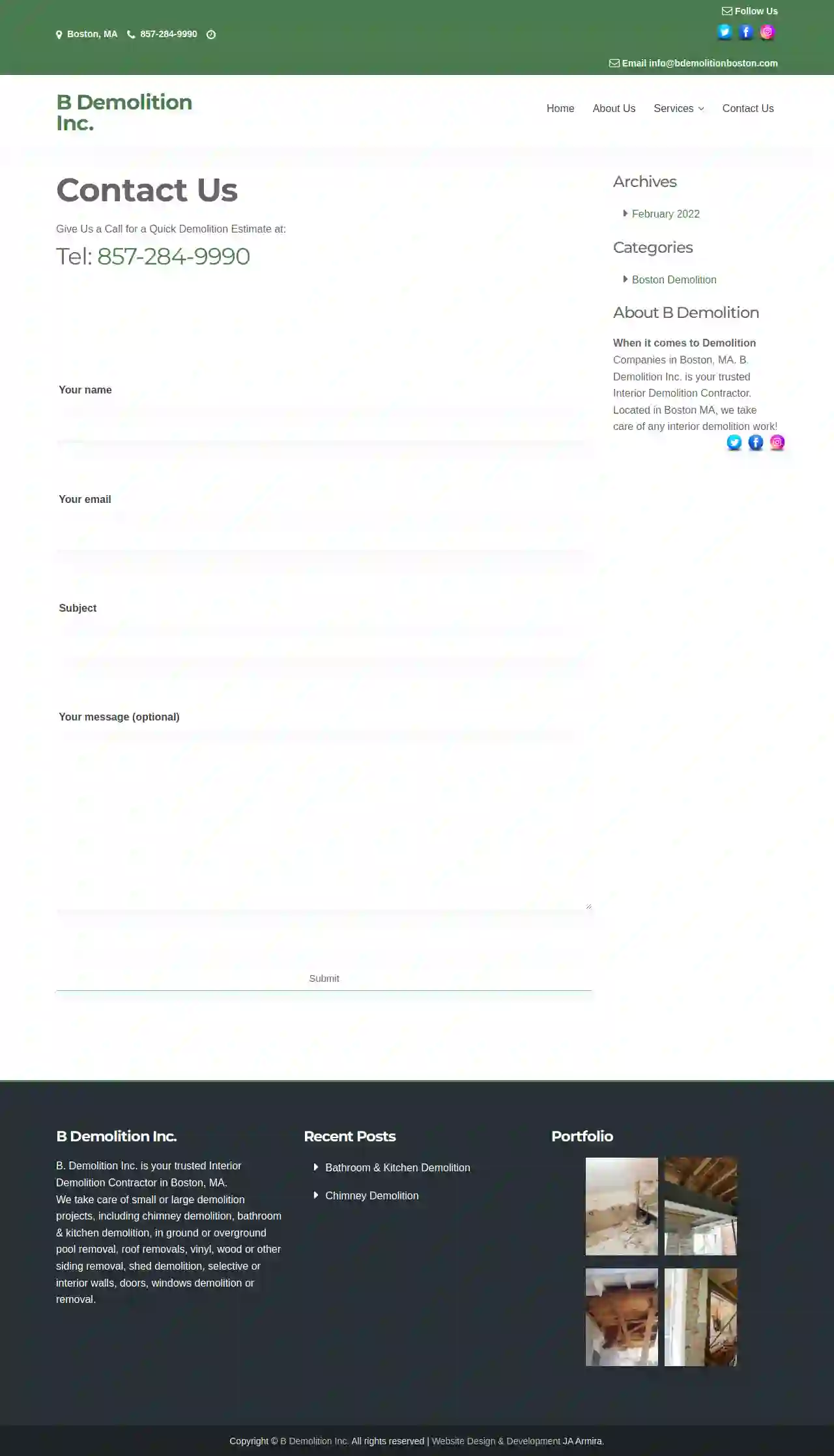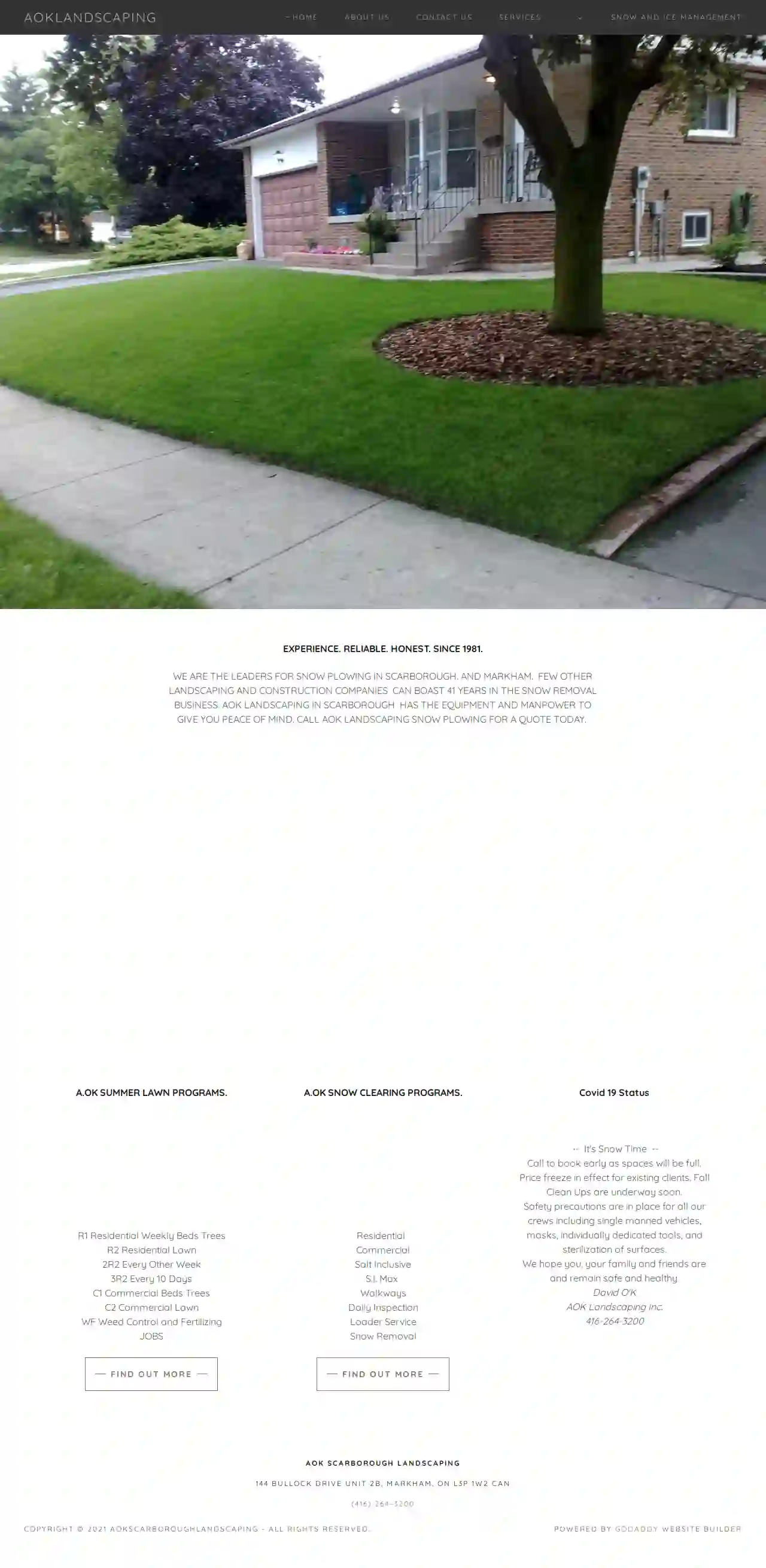Excavation Contractors Laceby
Top Excavating Contractor in Laceby
Get up to 3 Excavation Contractors Near Me quotes for your project today! Compare profiles, reviews, accreditations, portfolio, etc... and choose the best offer.

Seaside Landscaping & Excavation
PO Box 6632, Portland, 04103, GBAbout Seaside Landscaping & Excavation, LLC At Seaside Landscaping & Excavation, LLC, we understand that every customer has unique needs. We differentiate ourselves from the competition by providing professional and reliable services. We offer a wide range of services for both residential and commercial properties to meet your needs, from spring to winter. Seaside Landscaping & Excavation, LLC is dedicated to handling all your landscape and property service needs throughout the year. Our team is committed to providing exceptional service and exceeding your expectations. We take pride in our work and strive to create beautiful and functional outdoor spaces that you can enjoy for years to come. Whether you're looking for a complete landscape design and installation, or simply need help with weekly lawn mowing, we have the expertise and experience to get the job done right. Contact us today for a free consultation and quote. We look forward to hearing from you!
- Services
- Why Us?
- Gallery
Get Quote
K W Timmins & Sons Ltd
The Cottage, Tillbridge Lane, Sturton By Stow, LN1 2BP, GBFamily-run in Lincolnshire Since 1975 Timmins & Sons: established Groundworks & Agricultural Contractors We work with commercial & domestic customers within 50 miles of Lincoln. Explore how we help: I’m looking for a groundworks company Discover Service » I’m looking for an agricultural contractor Discover Service » I need land maintaining & looking after Discover Service » I’m looking for operated plant hire Discover Service » "Quality build and great team of lads" Ken Martin We're one of the only agricultural contractors in the area to offer... Forestry Mulching View Service Concrete Crushing & Screening View Service Discover some of the reasons our customers love to work with us: Local Contracting & Plant Hire Reliable & Trustworthy Adheres to Time Scales Get the job done right With over 35 years of dedicated construction groundwork and agricultural services. The Timmins family has been a dedicated agricultural contractor and plant hire service provider since 1975. Our values are the same today as they were over 35 years ago – a commitment to providing excellent agricultural and construction groundworks, underground irrigation works, farm contracting, operated plant hire, land maintenance, machinery and equestrian groundworks. Need a contractor to offer you a one-stop service? K W Timmins can offer the full works, from bespoke fabrication, agricultural contracting, groundworks, plant hire, and maintenance services - we can do the whole thing. Let us help your business run smoothly, we work hard to meet all your expectations and ensure everything is delivered to specifications and on time! About KW Timmins > Groundwork Services in Lincolnshire Need to prepare your site? We provide groundworks for commercial and industrial construction projects including foundations, site preparation, drainage and sewage. Concrete Crushing & Screening Discover Service » Full Screening Discover Service » Forestry Mulching Discover Service » Laser Screed Concrete Discover Service » Drainage Discover Service » Utility Cable & Water Pipe Laying Discover Service » Underground Irrigation Systems Discover Service » Site Clearance & Preparation Discover Service » operated plant hire We offer a comprehensive range of modern plant operated by our skilled and experienced workforce for all your plant hire needs. Tracked Jaw Concrete & Stone Crusher Extec & Sandvik Tracked 3way Split Screen Machine Tractor and Mulch/Flail Mowers Caterpillar, Hitachi and Bobcat 360 Tracked Excavators Vermeer 5750 4 Wheel Drive Trencher Terex, Thwaite
- Services
- Why Us?
- Testimonials
- Gallery
Get Quote
Demolition Contractor Boston
52 reviewsBoston, GBAbout B. Demolition Boston When it comes to Demolition Contractors in Boston, MA. B. Demolition Inc. is your trusted Interior Demolition Contractor. We take care of small or large interior demolition projects in Boston, MA, including, but not limited to: If you have a demolition project for your single house or a multifamily building, B Demolition Company is the demolition contractor... B. Demolition Services At B. Demolition Inc. We are always ready to give homeowners or general contractors, a hand on any interior demolition work in Boston, or any other town in Massachusetts. A simple chimney removal or bath & kitchen demolition project, we are fully insured and with more than decade of experience in all kinds of demolition and debris removal. Whether is a chimney removal or partial bath or kitchen demolition project partial walls demolition hardwood floor removal roofing removal Etc. at B Demolition we have an experienced crew with more than a decade of experience in all kinds of demolition work. We are fully insured for any interior demolition work and debris removal or site cleanups.
- Services
- Why Us?
- Gallery
Get Quote
MB Contracting
Yarmouth, 04097, GBExperience the Difference of Professional Excavation - Choose MB Contracting Unmatched Expertise and Precision for All Your Excavation Needs MB Contracting is a Local Grading Company Serving The Greater North Yarmouth, Maine Area At MB Contracting, we specialize in grading and construction site preparation, transforming raw land into functional spaces. From land clearing and demolition to significant landscape projects and erosion control, our excavating contractors are reliable and professional. We serve the greater North Yarmouth, Maine, area. Why Choose MB Contracting? Expertise Specialized knowledge and skills in precise digging, earthmoving, and site preparation. Advanced Equipment Utilization of state-of-the-art machinery for efficient and effective excavation services. Focus Adherence to strict safety measures, ensuring a secure work environment for all involved. Comprehensive Services Offering a range of services, including land clearing, demolition, and grading, for a one-stop solution to project needs.
- Services
- Why Us?
- Gallery
Get Quote
Archaeological Project Services
51 reviewsThe Old School, Cameron Street, The Old School Cameron Street Heckington Lincolnshire, Heckington, NG34 9RW, GBAbout APS Archaeological Project Services (APS) is a long-established organisation offering a comprehensive range of consultancy and fieldwork services. Based in Heckington, Lincolnshire, we serve clients across the construction and development industries, public bodies and private individuals throughout the country. Commission us APS offer cost-effective, tailor-made solutions to all archaeological and cultural heritage needs in the planning and development processes. Our highly experienced project management team will respond quickly to find the right solution for your project, from initial planning through site investigation to mitigation and report publication. Community Support for community-led heritage projects
- Services
- Why Us?
- Gallery
Get Quote
Broadland Building Services
Martham, Norfolk, England, United Kingdom, GBAbout Broadland Building Services Broadland Building Services has been trading for 15+ years in and around the Norfolk and Suffolk area. NO JOB IS TOO BIG OR TOO SMALL! We accommodate all jobs no matter the cost. The company is fully insured. We are a family run business who specialise in all aspects of building works. A father and sons company who have a combined experience in the industry reaching over 40 years. Our Team The team is made up of 3 men. Darren, Joshua and Byron who closely work together to offer a personal and professional service. Our team is made up of experienced and skilled individuals who are passionate about what they do. From our project managers to our skilled tradespeople, we work together to ensure that every project is completed to the highest standard. We believe in building lasting relationships with our clients, and it shows in the way we approach every project.The team is fully qualified in Carpentry and Bricklaying with NVQ and Diploma certificates. Our Services and Promises At Broadland Building Services, we offer a wide range of services to meet the diverse needs of our clients. Our services include New Builds, Extensions, Renovations, Conversions, Site Management, Project Management, Site Clearance, Civils, Plant Hire, Landscaping, Patio areas, Kitchens, Bathrooms, Roof Repairs, Plastering, Rendering, Decoration and much more. We work closely with our clients to understand their unique needs and deliver solutions that exceed their expectations. We are committed to delivering projects that are on time, within budget, and of the highest quality.
- Services
- Why Us?
- Our Team
- Gallery
Get Quote
Mantank Environmental Services Scunthorpe
3.73 reviewsCoal Pit Lane, Atherton, M46 0FY, GBMantank Environmental Services Mantank Environmental Services is a leading provider of environmental and drainage services across the UK. We have been trusted by our customers to deliver excellence since 1995, and we are committed to providing our clients with the highest quality services at competitive prices. Our Services We offer a wide range of services to meet the needs of our clients, including: Tank Cleaning Industrial Cleaning Sewage Tank Cleaning Tank Decommissioning Chemical Waste Disposal Environmental Services UK Water Tank Cleaning Dewatering Services Waste Management Company Water Jetting Vessel Cleaning Industrial Vacuum Sludge and Silt Removal Industrial Tank Cleaning SuDS Pond Maintenance CCTV Drain Survey Drain Camera Drain Clearance Drain Inspection Drain Repair Drainage Services Our Commitment to Excellence We are committed to providing our clients with the highest quality services. We are fully accredited and insured, and we have a team of experienced and qualified professionals who are dedicated to providing our clients with the best possible service. Contact Us If you are looking for a quote or just some advice, please feel free to contact us. We are always happy to help.
- Services
- Why Us?
- Accreditations
- Gallery
Get Quote
AOK LANDSCAPING INC.
4.47 reviews144 Bullock Drive, Unit 2B, Markham, L3P 1W2, GBEXPERIENCE. RELIABLE. HONEST. SINCE 1981. WE ARE THE LEADERS FOR SNOW PLOWING IN SCARBOROUGH. AND MARKHAM. FEW OTHER LANDSCAPING AND CONSTRUCTION COMPANIES CAN BOAST 41 YEARS IN THE SNOW REMOVAL BUSINESS. AOK LANDSCAPING IN SCARBOROUGH HAS THE EQUIPMENT AND MANPOWER TO GIVE YOU PEACE OF MIND. CALL AOK LANDSCAPING SNOW PLOWING FOR A QUOTE TODAY.
- Services
- Why Us?
- Gallery
Get Quote
Ten Four Landscape Construction
517 reviews4 Walker Road, Norfolk, 02056, GBTen Four Landscape Construction: Your Norfolk, MA Landscaping Experts Ten Four Landscape Construction is a full-service landscaping company in Norfolk, MA, specializing in hardscape construction, lawn maintenance, commercial snow removal, and more. Owner Seth Dias started working in landscaping as early as elementary school, helping his neighbors. His passion for landscaping grew, leading him to attend Norfolk County Agricultural High School to further his knowledge. Ten Four has flourished due to a commitment to honesty, accuracy, and open communication. They understand that every project is different, which is why they take the time to listen to the customer and work with a professional local landscape designer and highly-experienced crews to achieve their goals and exceed expectations. Whether you need routine seasonal maintenance or are looking to completely transform your property with a new patio, walkway, or outdoor living area, you can count on the team at Ten Four to take your property to the next level. Ten Four Landscape Construction is a family-owned and operated business that has been serving the Norfolk, MA area since 2012. They are fully licensed and insured, and they take pride in providing fair and honest estimates. Their projects stay on-time and on-budget, and you'll work with a professional landscape designer. They also offer 24/7 service for commercial snow removal.
- Services
- Why Us?
- Our Team
- Testimonials
- Gallery
Get Quote
North Terra Construction
4.25 reviews421A Bowes Road, Concord, ON, L4KIJ5, GBCommitment to Excellence With over 45 years of industry experience, North Terra Construction delivers exceptional earthworks services across the Greater Toronto Area. A hands-on approach has given our customers assurance that every detail will be accounted for and the project will run smoothly from the moment we land on site. Our crews are built with skilled and knowledgeable tradesmen that recognize a team effort is required to navigate the daily challenges that each job presents.
- Services
- Why Us?
- Gallery
Get Quote
Over 13,059+ Excavation Contractors on our platform
Our excavation providers operate in Laceby and surrounding areas!
ExcavationHQ has curated and vetted the Best Excavation Companies near Laceby. Find a trustworthy contractor today.
Frequently Asked Questions About Excavation Contractors
- Sloped Property: Your property has a significant slope, making it prone to soil erosion or landslides.
- Creating Usable Space: You want to level off a sloped area to create a flat surface for patios, gardens, or other outdoor spaces.
- Preventing Damage: Erosion is threatening existing structures, driveways, or walkways.
- Landscaping Features: You're incorporating tiered gardens, raised beds, or other landscaping elements requiring soil retention.
- Project Size and Scope: Larger, more complex excavations naturally take longer.
- Soil Conditions: Rocky or challenging soil types can slow down progress.
- Site Accessibility: Limited access might require more time for maneuvering equipment and hauling materials.
- Weather: Inclement weather can cause delays.
- Permitting and Inspections: Waiting for permits or inspections can extend the timeline.
- Project Size and Scope: The larger and more complex the excavation, the higher the cost.
- Soil Type: Different soil types require different equipment and techniques, impacting costs. Rocky or clay-rich soil can be more expensive to excavate than loose soil.
- Accessibility: Difficult-to-access sites might require specialized equipment or additional labor, increasing expenses.
- Disposal Costs: Hauling away excavated material (soil, rocks, etc.) to disposal sites incurs additional fees.
- Permits and Inspections: Depending on local regulations, permits and inspections might be required, adding to the overall cost.
How do I know if I need a retaining wall?
What is the difference between topsoil and subsoil?
Topsoil: The uppermost layer, typically rich in organic matter, nutrients, and microorganisms. It's essential for plant growth and is often darker in color.
Subsoil: The layer beneath the topsoil, containing less organic matter and generally denser. It provides support for roots but is less fertile than topsoil.
During excavation, topsoil is often removed and preserved separately for later use in landscaping, while subsoil is typically used for backfilling or other less demanding applications.
How long does an excavation project take?
How much does excavation cost?
How do I know if I need a retaining wall?
- Sloped Property: Your property has a significant slope, making it prone to soil erosion or landslides.
- Creating Usable Space: You want to level off a sloped area to create a flat surface for patios, gardens, or other outdoor spaces.
- Preventing Damage: Erosion is threatening existing structures, driveways, or walkways.
- Landscaping Features: You're incorporating tiered gardens, raised beds, or other landscaping elements requiring soil retention.
What is the difference between topsoil and subsoil?
Topsoil: The uppermost layer, typically rich in organic matter, nutrients, and microorganisms. It's essential for plant growth and is often darker in color.
Subsoil: The layer beneath the topsoil, containing less organic matter and generally denser. It provides support for roots but is less fertile than topsoil.
During excavation, topsoil is often removed and preserved separately for later use in landscaping, while subsoil is typically used for backfilling or other less demanding applications.
How long does an excavation project take?
- Project Size and Scope: Larger, more complex excavations naturally take longer.
- Soil Conditions: Rocky or challenging soil types can slow down progress.
- Site Accessibility: Limited access might require more time for maneuvering equipment and hauling materials.
- Weather: Inclement weather can cause delays.
- Permitting and Inspections: Waiting for permits or inspections can extend the timeline.
How much does excavation cost?
- Project Size and Scope: The larger and more complex the excavation, the higher the cost.
- Soil Type: Different soil types require different equipment and techniques, impacting costs. Rocky or clay-rich soil can be more expensive to excavate than loose soil.
- Accessibility: Difficult-to-access sites might require specialized equipment or additional labor, increasing expenses.
- Disposal Costs: Hauling away excavated material (soil, rocks, etc.) to disposal sites incurs additional fees.
- Permits and Inspections: Depending on local regulations, permits and inspections might be required, adding to the overall cost.